Sila Tripati
Antiquity 73, 1999 pp.827-35
The Lakshadweep Islands lie on the sea route between west Asia and Africa on the one hand and south Asia and the Far East on the other. In maritime history, these islands have played a vital role by providing shelter, fresh water and landmarks to navigators through the ages. Recent discoveries made during marine archaeological exploration and excavations in the Lakshadweep have revealed evidences of early settlement and shipwrecks. The findings suggest that the islands had been inhabited much before the early historical period.
Introduction
India, one of the oldest maritime nations of the world, has been maintaining commercial and cultural contacts with African. Arabian and Southeast Asian countries for the last 5000 years. The findings of excavations at various coastal sites of India have provided convincing evidence of such relations.
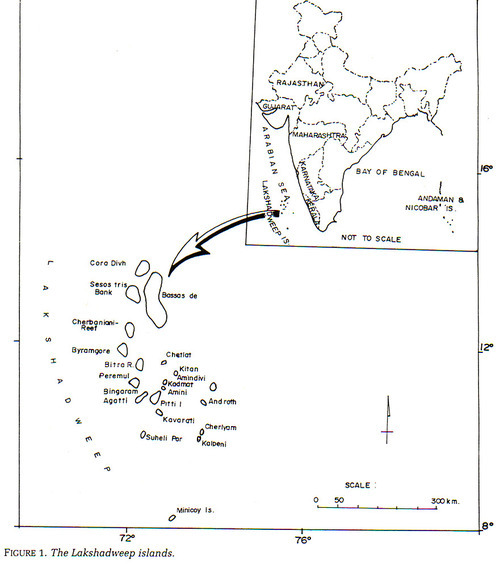
The group of 36 islands scattered off the southwest coast of India between latitudes 8 degrees and 12 degrees 37 minutes N, and longitudes 71 degrees and 74 degrees E are known as the Lakshadweep (Laccadives). The word laksha is derived from the root lag, meaning a mark or sign. In addition to these islands, there are a number of submerged banks, open reefs and sand banks in this region. Only 11 of these islands are inhabited: while the rest are small and serve as satellites of the inhabited islands.
Minicoy is the southernmost island of this group, separated from the rest by the Nine Degree Channel. Kavaratti, Kalpeni. Androth and Agatti form the southern group while Amini, Kadmat, Kiltan, Chetlat and Bitra make up the northern group of islands of Lakshadweep. All the islands are generally oriented north-south except Androth which lies east-west.
These islands are famous for their beautiful lagoons, colourful coral reefs and clean coralline beaches. Most of them are enclosed by lagoons with coral reefs on the western sides, protecting them from the fury of the monsoon. The lagoons are 0.5 - 1.5 km long with a maximum water depth of 10 m.
Earlier these islands were known as Divis or Dibajat which means islands. The islanders identify themselves as Divis even today. The Lakshadweep Islands lie on the sea route between west Asia and north Africa on one side, and south Asia and the Far East on the other. These islands have been known to navigators of various countries and served as good landmarks for sailors, places for refuge in case of mishap and for replenishment of fresh water etc. Therefore, ancient seafarers of India as well as other countries might have taken shelter on the Lakshadweep, particularly in case of emergency.
The early settlers were people from Gujarat, Kerala and Tamil Nadu. These people were engaged in maritime trade between the mainland of India and the Arab and African countries, as well as with the western world. Country craft called Odams and Bandodies provided the only means of communication between the islands and mainland (Bhatt 1997). Such seafarers might also have crossed to other islands, namely the Maldives and the Andaman and Nicobar group of islands on their way to the far eastern countries.
Geology & geomorphology of the Lakshadweep Islands
Geologically these islands are a part of the Indian subcontinent and wore separated due to faulting of the ridge 53—54 million years ago. The rock stratum is a continuation of the Aravalli hills of Rajasthan (Mannadiar 1977). The Lakshadweep Islands do not show any major topographic features and are mostly low and flat-topped with a height of less than 6 m above sea-level. Most of the islands are long and irregularly shaped. They are believed to have been formed as the result of coral growth.
The soil is porous, and lakes, rivers or streams are completely absent. Drinking-water is drawn from wells and tanks on the inhabited islands. The water is hard and a little brackish in some places.
The eastern seaward shores of all the islands except Kadmat, Agatti, Bangaram and Cheriyakara are marked by rough waters. The eastern shelf of the islands rises precipitously from the sea enabling ships to get very close to the islands (Athawale 1991).
ObjectivesThis paper aims to synthesize the information available from earlier explorations and excavations in the Lakshadweep including the work carried out by the National Institute of Oceanography (Vora 1994; Gaur et al. 1998). The objectives of these explorations have been to locate archaeological sites on land and collect data for reconstructing cultural contacts, to trace the trade links of these islands with the mainland, and to locate shipwrecks in Lakshadweep waters.
Historical evidence
These islands were known to the sailors of various countries since the early historical period. The earliest reference to these islands is made in the Periplus of the Erythraean Sea, by an anonymous author of the 1st century AD, who refers to the islands off Damirica (the name assigned to Malabar at that time), in connection with the export of tortoise shell (Casson 1989; Schoff 1974).
Another early reference is by Ptolemy (150 AD), who states that opposite Taprobane (Sri Lanka) lies a multitude of islands said to number 1378 (McCrindle 1885). H.C.P. Bell (Gabriel 1989) identified the names of some of the islands mentioned by Ptolemy, e.g. Kanathra=Kavaratti, Argidion=Agatti, Ammine=Amini, and Monache=Minicoy.
Historians such as Ammianus Marcellanus (320-390 AD), Fa-Hien (5th century AD), Cosmas (535-550 AD), El Masudi (916 AD) and Ibn Batuta (1343-44 AD) have also referred to these islands and the Maldives (Pyrard 1888:426-34).
A hoard of more than 400 Roman coins of 119-138 AD was found at Kadmat (Turner 1989) and also reported from Androth (Mohandas 1951). The finding of these coins shows that during the early centuries of the Christian era, the Romans had trade contacts with the Lakshadweep islands. The islands were also referred in Buddhist Jataka stories and inscriptions.
Some indirect references to naval wars also come from the Vayalur inscriptions near Mahabalipuram in Tamil Nadu, such as the one which mentions that Narasimha Varman II Rajasimha (680-720 AD) of the Pallava dynasty conquered the Lakshadweep Islands (Sastri 1925-26). The inscription reads: May he exercise the royal prerogative and take up the vow of administering (his) subjects up to the extremities of his kingdom, as even to include the Dvipalaksham (thousands of islands).
The Narendra inscription of Shashthadeva, the Kadamba king of Goa, states that he had conquered Kavadi dvipa, which seems to correspond to Kavaratti, the capital of Lakshadweep (Rao 1994). Similarly, the inscription from the Rajarajeswar temple of Tanjavur mentions that Rajendra Chola (1018-19 AD) conquered many islands including the Lakshadweep (Mannadiar 1977). These naval wars reflect the importance of the Lakshadweep at that time.
The 11th-century AD Sanskrit text Mooshakavamsa also refers to the annexation of these islands by the king of Vallabha (Rao 1916).
Archaeological background and onshore explorations
Human settlement in the Lakshadweep is believed to have taken place around 1500 BC because the ancient ports of the west coast of India were exporting Indian merchandise to East Africa and other countries. Excavations at Lothal in Gujarat have revealed the presence of terracotta gorillas revealing Indian sailors’ links with the East African coast (Rao 1973). Recent excavations at Kalpeni have yielded terracotta objects dating back to 1500 BC supporting the hypothesis that these islands were occupied from 1500 BC, if not earlier (Saigal 1990).
Onshore explorations were carried out at islands of potential archaeological and historical importance, in order to establish the time frame and correlation with history. Onshore explorations at Kavaratti, Androth, Agatti and Amini unearthed red ware, dull red ware, buff ware and Red Polished Ware (RPW) (Rao et al. 1995-96).
The scraping near the Ujira Habibullah Mosque mound of Kavaratti brought to light a number of potsherds; the majority of them belong to red ware and a few are dull red ware and black ware (FIGURE 2 below).
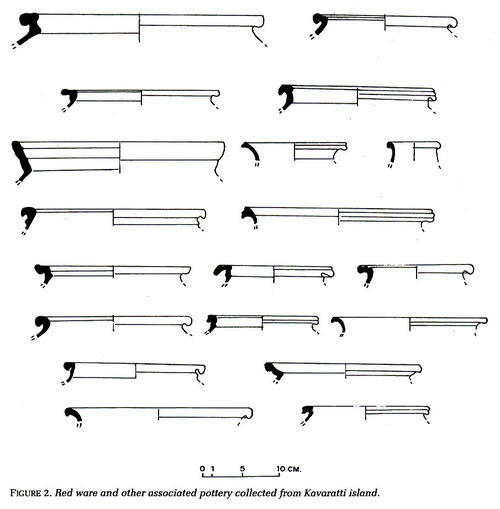
Large quantities of red ware, dull red ware and a few black ware were also found in the habitational mound of Androth (FIGURE 3 below). All potsherds collected from Kavaratti and Androth are small and the main shapes are pots and small jars, rendering it difficult for identification of any incised designs and paintings. Probably painting might have been destroyed due to the marine environment.
The collection mainly includes rims of different types, namely grooved, splayed-out rims, squarish grooved etc. Interestingly, no bases or other parts of pottery were found during the exploration. The pottery is mostly ill-fired and the fabric is medium to coarse and medium to thin in section. These are wheel-made, and striation marks are visible in the interior. Most pot-sherds have pitting marks. Only one shred of glazed ware with blue designs was found at Kavaratti. No glazed wares were found in Androth.
Earlier exploration by the Archaeological Survey of India (ASI) had revealed two phases of occupation in a section having a gap with sand deposit and an ancient structure at the top (FIGURE 4 below) (ASI 1983-84).
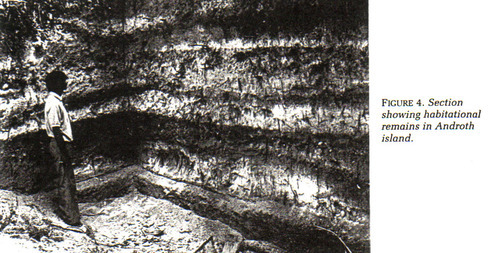
At another place on Androth potsherds were found at different levels, the lowest lying at a depth of 2.5 m just above the coral sand, indicating that the island was occupied after the coral formations had been exposed for some time. Detailed examination of this section revealed evidence of three other levels of human occupation (FIGURE 5 below).
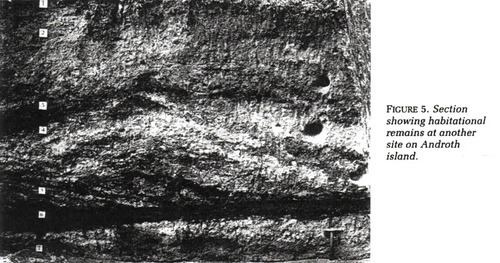
The occupational levels yielded potsherds, black ashy deposits and fragments of animal bones (A.K. Sharma pers. comm.). Locally the mounds are known as ‘Kalikatta’ and ‘Kunthathupalli’. Medieval pottery was found in the Jama Mosque. Mazar and Waliullah Mazar area of Agatti. It is however reported that some sculptures of earlier period were also found in this island. A trench which was being excavated for the foundations of a public building was examined at Amini where red ware and coarse grey ware of early historical and medieval periods were noticed (Rao et al. 1995-96). The occurrence of a small tank in the presently uninhabited island of Cheriyam reveals that it was inhabited during earlier times. Besides coins and pottery a coral block with a demon face, protruding canine and tongue was also found in Androth. Similarly, a granite piece was found from a house in Kalpeni on which a headless female figure was carved in low relief, with folded hands and standing on a makara. On the left side of the figure, a tofa-shaped pot and on the right side a ‘T’-like object, probably the wooden handle of a ploughshare, have been depicted. The figure appears to be that of goddess Ganga (A.K. Sharma pers. comm.).
Similarly, red-ware sherds, celadon and glazed ware were also collected during explorations at Kurumathi, Landu and Kudahuvadu islands of Maldives by ASI (FIGURE 6 below).
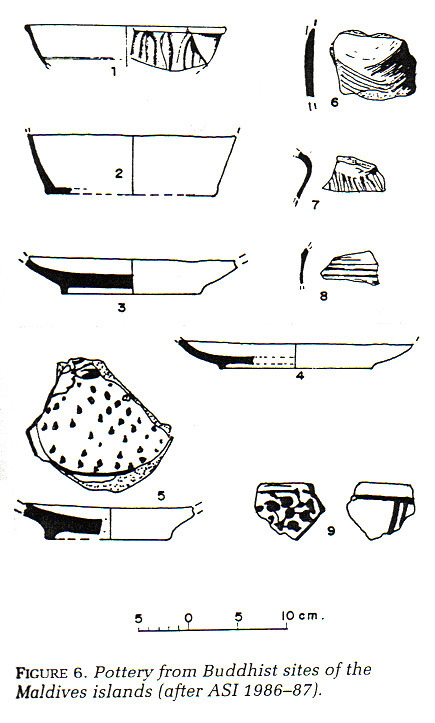
The red-Ware sherds do not have any slip, wash or designs. The main shapes are carinated bowls, jars, handis and lids. The striation marks on the pottery suggest fast wheel-manufacturing technique (Gupta 1995). From the potsherds found in the Buddhist establishments only one was glazed ware, whereas the others were red ware and celadon ware. Potsherds of celadon and glazed ware have floral decorations. The noteworthy finding was the Celadon ware bowl With floral design on its lip.
Buddhism in Lakshadweep
The Buddhist Jataka stories of the 6th century refer to the Lakshadweep and Maldives groups of islands. The ships which plied between Bharukaccha in Gujarat and southeast Asian countries would cross the Lakshadweep and Maldive islands and some of these might have been wrecked bv subsurface reefs. However, very little is known about Buddhism in the Lakshadweep Islands. Recent explorations have provided evidence of Buddhism in the islands.
The evidence indicates that Buddhism reached Lakshadweep at an early date, probably at the same time when Ashoka the Great sent his emissaries to Sri Lanka. Three idols have been found in Androth island which are kept in the storeroom of the Government high school. Of these, two are Buddha heads and one is Yaksha. The larger of the Buddha heads is significant because its height, the facial expression with half-closed eyes, long ears, curly hair and meditation posture indicate that it belonged to the Gupta period 400-500 AD (FIGURE 7).
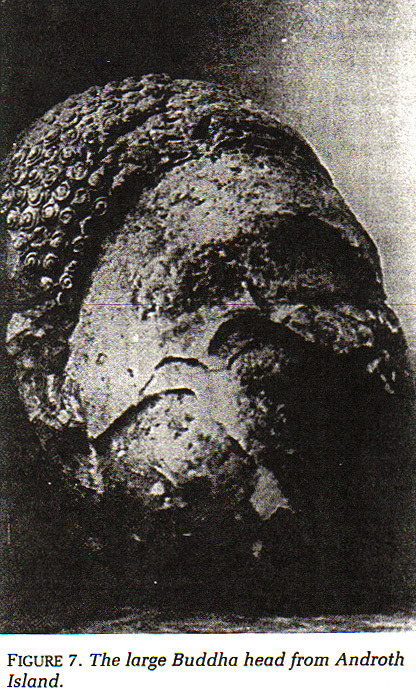
The height of the larger head is 100 cm and its circumference is 116 cm; the smaller Buddha head weighs 70 kg, and its height and circumference are 68 and 116 cm, respectively. The Yaksha-like figure with protruding canine is about 125 cm high (FIGURE 8 below).

Some human sculptures carved out of coral slab were also noticed. These heads were recovered from a huge mound called ‘Perumpalli’ in the southern centre of the island while digging foundation-trenches for a school building. Perumpalli means a great Vihar. Similarly, a Buddha head was also discovered during the trial digging near the General Hospital in Kavaratti in 1971. This measures 40 cm in length and 30 cm in width. It seems that the torso was thrown into the lagoon of the island. All these idols are much damaged and defaced, probably by local people.
In Minicoy island also, similar Buddha heads were recovered from the mound of Aludi and eastern shore of Sedivalu village (Sharma & Khan 1994). Another Buddha head measuring 50 cm in height and 35 cm in width was recovered from a mound of Minicoy. The socket at the back is meant for attachment to the torso. These heads are much damaged and facial features are disfigured due to flaking of the plaster. The idols are made of coral rocks. The coral blocks were first shaped like a human head and the plastered with coral paste and the details carve The curly hair, broad forehead and ears clearly visible but the facial portions have been damaged.
The explorations by ASI have yielded a large number of Buddhist remains such as stupa monasteries, water tanks and enclosure wall at Kuramathi, Kudahuvadu. Toddu, Landu Nilandu North and Ariadu in the Maldives. All these are now in ruined condition and mosques and houses have been constructed on these remains. Beads of semi-precious stones, ornaments of gold and silver and terracotta figurines etc. were found in a relic chamber of stone at a Buddhist complex of Kuramathi (ASI 1986-87).
Discussion
Since the people of the Lakshadweep Islands do not have any aboriginal groups, scholars had postulated different views about the history of habitation on these islands. Now it is clear from archaeological research that settlement started in these islands before the early historical period. Onshore explorations at Kavaratti, Agatti, Androth and Amini revealed that the earliest settlement probably took place between Pre-Christian period and the 5th century AD, as is evident from the RPW, red ware, dull red ware and red and black ware.
The pottery mainly found at Androth, Kavaratti, Amini, Agatti and Kalpeni were probably imported from the mainland. As there is no availability of clay in these islands and all pottery was probably imported, all pottery found in these islands is similar in fabric and typology. No datable antiquities have been found along with pottery during our exploration in these islands.
The RPW is recognized as one of the most important ceramic products of the early historical period of India datable to the early Christian era till the 5th century AD. Fragments of RPW are reported from a number of sites in India. This ware is made of well-levigated clay and a thick red slip is polished on this ware. Due to firing at a high temperature these vessels are sturdy and produce a metallic sound. The colour varies from dark red to pink. The main shapes are sprinkler and Surahi which is widely distributed, and the other types are jars with grooved rim. flaring neck, bulbous body and ring-footed base. The bowls have incurved, beaded and thick rims, carinated shoulders and convex sides. The earlier impression of the archaeologists was that the RPW was imported or could be an imitation of the Roman Samian ware. From its wide distribution in various types, it is considered to have been indigenous during Pre-Christian era.
The occurrence of pottery in Lakshadweep and the Maldives is significant as there is no clay for manufacture and hence it might have come either from India or Sri Lanka. The Buddha heads at Androth, Minicoy and Kavaratti suggest that Buddhism prevailed in those islands since the 5th-6th centuries AD or earlier. The style of these figures resembles those of a particular period of the mainland Buddhist centre. The figures are made out of local coral rock. Presently these Buddhist antiquities are lying in public buildings, in bad condition and in need of urgent attention and preservation. The antiquities and Buddhist relics which were found during exploration and excavation in the Maldives are now kept in National Museum at Male’.
ConclusionsThe discovery of Buddha heads and other antiquities clearly indicates that Buddhism prevailed in the Lakshadweep Islands during the 5th-6th centuries AD. As the Lakshadweep Islands lie on the trade route, settlement on these islands is expected to be much older, but those may have been temporary settlements.
To unearth the past history of Lakshadweep, and to verify the findings of Saigal (1990), it is essential that archaeological excavation should be undertaken at least at Kavaratti, Androth and Minicoy islands. If the findings are correct then the history of settlement of Lakshadweep would be much older than the early historical period.
Further, in-depth explorations should also be carried out at other islands where Buddhist remains have not been reported; the results of exploration may bring some other new evidence on the archaeology and history of Lakshadweep.
Acknowledgements: The author is grateful to the Director (NIO) and Shri. K.H. Vora. Scientist-in-Charge, for granting permission to publish this paper, also to Drs M.C. Joshi and A.K. Sharma for providing information on Lakshadweep. Thanks are also due to all the colleagues of MAC for their participation in the cruise and collection of data. The author also thanks Shri. S.B. Chitari for drawings and Shri. S.N. Bandodker and Shri. Sheikh Ali for photographs.
References
ASI, 1983-84. Indian Archaeology 1983-84 - A review. New-Delhi: Archaeological Survey of India.
1986-87. Indian Archaeology 1986-87 - A review. New Delhi: Archaeological Survey of India.
ATHAWALE, S. 1991. India’s Indian Ocean islands. New Delhi: ABC Publishing House.
BHATT, S.C. (ed.). 1997. The Encyclopaedic District Gazetterrs of India 2. New Delhi: Gyan Publishing House.
CASSON, L. 1989. The Periplus Maris Erythraei. English and Greek text with Introduction, translation, and commentary. Princeton (NJ): Princeton University Press.
GABRIEL, P.C.T. 1989. Lakshadweep — history, religion and society. New Delhi: Books & Books.
GAUR, A.S., K.H. VORA, SUNDARESH, S. TRIPATI. P. GUDIGAR & S.N. BANDODKAR. 1998. Exploration of steam engine wrecks off Minicoy Island. Lakshadweep. India. International Journal of Nautical Archaeology 27/3: 225-36.
GUPTA. S.S. 1995. Buddhist remains’in Maldives. Puratattva 25: 77-80. New Delhi: Indian Archaeological Society.
McCRINDLE. J.W. 1885 [1985]. Ancient India as described by Ptolemy. New Delhi: Today & Tomorrow’s Printer & Publishers.
MANNADIAR, N.S. (ed.). 1977. Gazetteer of India - Lakshadweep. Coimbatore: Government of India Press.
MOHANDAS. P.N. 1951. Our numismatic collection, in Madras Central Government Centenary Souvenir 1851-1951. Madras.
Pyrard. F. 1888. The voyage of Francois Pyrard of Laval to the East Indies, the Maldives, the Moluccas and Brazil 2(1). (Tr. Albert Gray.) London: Hakluyt Society. First series no. 77.
RAO, S.R. 1973. Lothal and the Indus civilization. New York (NY): Asia Publishing House.
1994a. Marine archaeological exploration of Byramgore reef of Lakshadweep in the Indian Ocean, in Rao (1994b): 67-9.
(Ed.). 1994b. Role of Universities and Research Institutes in Marine Archaeology. Goa: National Institute of Oceanography.
RAO. S.R.. K.H. VORA. A.S. GAUR. P. GUDIGAR. SUNDARESH & S. TRIPATI. 1995-96. A preliminary shipwreck exploration off Lakshadweep. Journal of Marine Archaeology 5-6: 23—31.
RAO. T.G, 1916. Tranvancore Archaeological series 2. Tranvancore.
SAIGAL. O. 1990. Lakshadweep. New Delhi: National Book Trust.
SASTRI. H.K. 1925-26 [1983]. The Vayalur inscription of Rajasimha II. Epigraphia Indica 18: 145-52. New Delhi: Archaeological Survey of India.
SCHOFF. W.H. 1974. The Periplus of the Erythraean Sea: Travel and trade in the Indian Ocean by a merchant of the first century. New Delhi: Oriental Books Reprint Corporation.
SHARMA. A.K. & M.F. KHAN. 1994. Buddha heads and some grave head stones from Lakshadweep, in Rao (1994b): 129-31.
TURNER. P.J. 1989. Roman coins from India. London: Institute of Archaeology. Occasional publication 12.
VORA. K.H. 1994. Marine archaeological explorations in Lakshadweep waters. Technical Report NIO/TR-9/94: 1-27. Goa: National Institute of Oceanography.
(Source: maldivesculture.com)
No comments:
Post a Comment